.

WEDNESDAY, NOV 13, 2019: NOTE TO FILE

Carrying Capacity and Overshoot
 The objective view
The objective view
'For the first time in history a conviction has developed among those who can actually think more than a decade ahead that we are playing a global endgame. Humanity's grasp on the planet is not strong. It is growing weaker. Our population is too large....' — Edward O. Wilson, Half Earth: Our Planet's Fight for Life 2016
'In a time of universal denial and deceit — telling the truth is a revolutionary act.' — George Orwell might have said something like this, but didn't.
'The carrying capacity concept has become essential for understanding what is now happening to human societies, and consequences to follow later.... To appreciate the relevance of carrying capacity to human lives and humanity’s future, we need to acknowledge some neglected (but obvious) facts.' [William R. Catton, Jr., 2013, who views carrying capacity as foundational to understanding overshoot, continues:]
- Human beings are organisms. ['The first thing you have to realize is that you are an animal.' —David Suzuki]
- Every organism, whether plant or animal or whatever — as a bounded bundle of living substance — is distinct from its surroundings. But life’s processes involve interaction of that bounded bundle with those surroundings. To live, an organism has to use its environment in three ways.
- To maintain its life, any organism must take in substances (and energy) from outside its body. [E.g. water as substance and food as energy.]
- Living bodies, as physical entities, occupy space; their lives depend on having sufficient room for their existence and normal activities. [E.g. a habitat that provides water and food within limits.]
- The organism’s biochemical processes necessarily transform the substances taken in from the environment. The transformed products of such metabolism differ not only from the original environmental components but some also differ to some extent from the tissues of the organism. Being harmful (toxic) if retained within the organism, these products have to go somewhere. So they are excreted -- returned to an environment (as eventually also the dead remains of the organism will be returned).
'In short, any living thing requires an environment from which to obtain sustenance materials, including energy, in which to exist and do whatever it does, and into which to discard stuff. A novel but useful way to express this is to note that organisms inevitably use their surroundings in three kinds of ways: All living beings do some “from-whiching,” some “in-whiching,” and some “into-whiching.”... The term carrying capacity simply means, therefore, the maximum amount or intensity of a given kind of use, or the maximum use-load, an environment can endure while retaining its future suitability for that use...'.
'The intensified misery and competition for dwindling supplies the carrying capacity deficit will entail is likely to encourage a kind of paranoid imputation of culpability. “Others” will be vilified and blamed; overt conflict on various scales will be likely, contributing to a period of population reduction, unplanned, merciless, deplored, self-reinforcing. Societies will fall into disarray. Historians will discover clues that “should have been recognized” but were not. Only ecologists, some of them, will truly understand the rise and decline of human carrying capacity and the rise to dominance and fall therefrom by Homo colossus.' —William R. Catton, Jr. Carrying Capacity: What Is It? How Have We Misunderstood It? And Why Is It Important? 2013
Eric Lee, A-SOCIATED PRESS
TOPICS: ENDEAVOR, FROM THE WIRES, TO THINK WELL
Abstract: Paul Chefurka's article is a good intro to ideas of systems ecology that matter, the 'objective view' of carrying capacity, overshoot and sustainability. Paul obviously endeavors to think well because he does, even if he is a doomer. Doing so involves endeavor as there is no easy path to mastery. Warning: extraordinary claim made—that we went into overshoot about 3k - 4k years ago or before, backed by extraordinary evidence if you can reason about it. An intro has been added and comments follow. George Mobus, current ISSS (International Society for the Systems Sciences) president, recently mentioned the obvious, that carrying capacity/overshoot are Reality 101 concepts that humans who would persist on the planet need to understand. So I added to Paul's article (I throw a bunch of claims at the wall to see what might stick—sorry about that) and made it a feature article to reference. Paul's article is now in the middle. [Paul seems to be a fellow traveler. He left his legacy (2007-2013) before I started to in 2015, and transitioned to the Bodhi path. I'm finishing up my legacy and am a 'devout follower' of Zhen. Of course, I don't know Zhen. She could be a 15-year-old with Asperger's living in her parent's basement. Or I'm thinking (I devoutly feel I know) that Donella Meadows, among her other talents, was Zhen. Why follow two Masters when I can conflate them? I also follow Athena, my Doggiesattva and therapy dog, in memory still warm. You can't follow Zhen; but you can be Xin.]
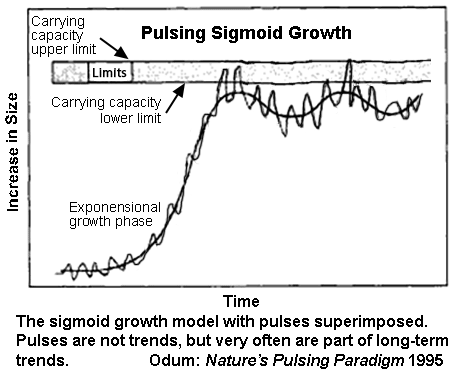 COOS BAY (A-P) — The simply delivered argument: a species that causes other species to go extinct has exceeded its carrying capacity (causing damage/degradation to habitat), therefore humans exceeded carrying capacity (began to cause significant, obligate species extinction) when our population exceeded about 35 million 3k to 4k years ago (or earlier). We are now presiding over the greatest mass extinction event since the late Cretaceous (one that did not begin in 1970), one that could rival that of the Permian, and we are nearing the climax of our one-off global overshoot event.
COOS BAY (A-P) — The simply delivered argument: a species that causes other species to go extinct has exceeded its carrying capacity (causing damage/degradation to habitat), therefore humans exceeded carrying capacity (began to cause significant, obligate species extinction) when our population exceeded about 35 million 3k to 4k years ago (or earlier). We are now presiding over the greatest mass extinction event since the late Cretaceous (one that did not begin in 1970), one that could rival that of the Permian, and we are nearing the climax of our one-off global overshoot event.
For eons our ancestors were K-strategists whose populations fluctuated at or near the carrying capacity (K) of the environment in which they resided. We modern techno-industrialized humans are a one-off plaque-phase population of a species that has been regionally repeating the pattern of overshoot and collapse since agro-empowered empire building began.
Unlike some locusts, for example, we are not adapted to overpulsing our population, so there will be no evolvable outcome, merely a dissipative one (e.g. hurricanes are dissipative structures that adapt to terrain but do not evolve). Few public intellectuals, including eminent ecologists, argue (in public) that a human population of more than 2 billion is not remotely sustainable long term (any 'thought leaders' saying much less would not remain thought leaders).
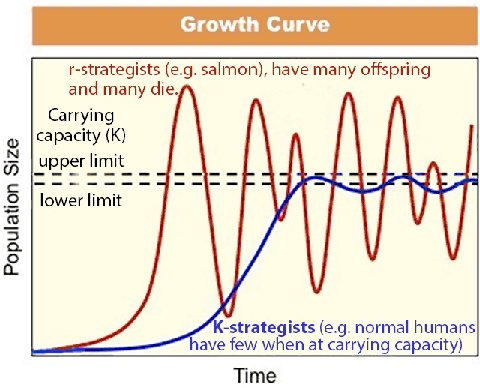 If humans are to understand the planet and learn to live with it properly long term, we need to become K-strategists again. This means our population would, objectively thinking, likely need to be in the 7-35 million range globally given that to persist we must leave significant room for Nature. Our complex monetary growth culture is adaptive but not evolvable (like cancer it selects for its own failure), and our collective inability (so far) to understand this may have extinction as outcome (or worse, we make fusion work and become Borg-like expansionists, assimilating all worlds for the taking in the Milky Way before spreading to other galaxies).
If humans are to understand the planet and learn to live with it properly long term, we need to become K-strategists again. This means our population would, objectively thinking, likely need to be in the 7-35 million range globally given that to persist we must leave significant room for Nature. Our complex monetary growth culture is adaptive but not evolvable (like cancer it selects for its own failure), and our collective inability (so far) to understand this may have extinction as outcome (or worse, we make fusion work and become Borg-like expansionists, assimilating all worlds for the taking in the Milky Way before spreading to other galaxies).
Defining terms is a start:
Carrying capacity: the population of a given species that can be supported indefinitely in a defined habitat without permanently damaging/degrading the ecosystem upon which it is dependent; the number of people, other living organisms, or crops that a region can support without environmental degradation.
When a species exceeds carrying capacity (the upper limit) it causes permanent damage to the biome it depends upon, whether a small watershed area or planet Earth. When a species' footprint causes the extinction of other species, that impact is permanent and involves environmental degradation. So one measure of ‘degradation’ is 'causing species extinction' which is objectively measurable. We are currently causing the greatest mass extinction event since the late Cretaceous. When did excessive impact begin? We regionally exceeded carrying capacity when we became a technology-using invasive species spreading beyond the African savannas in which we evolved (as megafauna in Africa co-evolved with us, they did not go extinct). The rate of anthropogenic species extinction is now over 1,000 times baseline, heading towards 10,000 times higher by the end of this century. Humans exceeded carrying capacity when the population of our Anthropocene enthusiast ancestors (regionally causing megafauna extinctions on five continents) exceeded a few million. We moderns, evidently, are far more enthusiastic now than they were.
Upper carrying capacity (overcarry) limit: the number of people, other organisms (including crops/livestock/pets) that a region can support without environmental degradation caused by a plague-phase overpopulation of the species causing the degradation, an overshoot event that goes too far and degrades carrying capacity, resulting in the species' depopulation (e.g. locusts, modern techno-industrial humans); the population level associated with overpulsing. Bumping against the lower limit and occasionally exceeding it before corrective feedbacks is common, i.e. normal.
With no predators on St. Matthew Island, the introduced reindeer were able to blow past the long-term sustainable maximum population the island could support by consuming an island larder of stored lichen (not unlike we are consuming a planetary larder of fossil fuels). Assuming all primary productivity ultimately goes to supporting reindeer, when their population exceeded about 900, they exceeded the maximum carrying capacity limit of the island. When the reindeer population reached 600, one more doubling would be too much due to lag time. At 600, the population needed to slam on the brakes to avoid overshoot. To double three to four more times lead to a die-off event. Like the reindeer population a 5,000, the human population at 8 billion will not double again.
The reindeer population continued to grow until it reached about 6,000 as the mass of stored lichen/grasses available was greater than the annual population growth (until it wasn't). The maximum population of humans this planet could sustainably support without exceeding the overcarry limit (entering overshoot), may be in a 7-35 million range, i.e. we went into overshoot long before our population reached 3.7 billion in 1970. Overshoot events subjectively seem like the best thing ever on the upslope, but they will climax, followed by descent. Sorry about that.
Ecological overshoot: occurs when a population's demand on ecosystem productivity exceeds the capacity of an ecosystem to regenerate the resources consumed and absorb wastes, resulting in degradation (a lowering of carrying capacity), unlike the pulsing paradigm norm where exceeding the lower limits of carrying capacity results in adaptive corrections within the long-term limits without causing species extinction [Nature's Pulsing Paradigm]. As applied to humans, overshoot is a state in which human consumption of resources exceeds the regenerative capacity of ecosystems (or the geobiosphere) and/or the production of wastes exceeds the assimilative/recycling capacity of ecosystems (e.g. biotoxins, microplastics, N, P, CO2).
Our species lived for 300 thousand years on the African savanna with regional populations pulsing under the carrying capacity of the environment, sometimes pushing carrying capacity limits before negative feedbacks (e.g. conflict over scarce resources, starvation, abortion, infanticide, eldercide, stress, non-reproductive sex) lowered the population (a General Adaptation Syndrome response). Overshoot causing the extinction of other species is an extreme measure of overshoot. The African savanna population of humans was less than a million. From the POV of our ancestors before agriculture and empire building began, long after humans spread out of Africa to number about 5 million, we technoindustrial humans, living mostly in cities, are short-termers living a systems pathology life as an invasive species or metastatic cancer-like complex society prior to correction. A maximum human population that would not cause species extinction (assuming humans live as agents of the Earth and work to restore Nature and promote the evolution of new species to replace those already driven to extinction) may be as high as 35 million.
Overpulsing paradigm: pulsing above the upper carrying capacity limit, commonly associated with invasive species lacking control feedbacks, results in one-off overshoot population growth followed by population descent/collapse; e.g. reindeer on St. Matthew Island, modern techno-industrial humans.
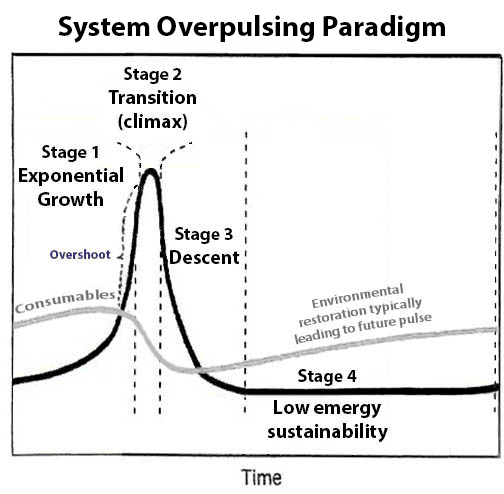
A pulsing population within/below carrying capacity is the norm. Conditions that allow overpulsing unto overshoot followed by a mass die-off is not, with few exceptions such as yeast who have adapted by being able to sporulate, or locusts who undergo phase-related morphological and behavioral changes that select for some to survive and transition back to a pulsing paradigm norm for some years until favorable conditions again allow plague-phase swarming.
Humans have no adaptation to overpulsing. If 500 million humans could be supported on planet Earth without turning fossil fuel into food, then we overpulsed our population about 370 years ago. Because of fossil fuel inputs, negative feedbacks have yet to make corrections. As humans have no prior experience with global collapse (just regional for the last 11k years), no literate humans may survive our descent phase (e.g. Indus Valley Civilization). From the objective view of Paul Chefurka, humans began overpulsing regionally over 10k years ago and by 3k-4k years ago most humans were living in chiefdom level proto-empires to state level empires (aka civilizations), i.e. most were living in unsustainable regional plague-phase complex societies.
Humans may again live long and prosper without conquest or overexploitation of weaker humans and/or environmental resources. We may again live well by not causing species extinction or perhaps even assisting new species to evolve to replace those we have and will cause the extinction of until we go extinct or transition to non-plague forms. This may occur when our population again numbers in the millions (a few or a few tens of millions).
'Only' a few million, however, may be unthinkable to us short-termer Anthropocene enthusiasts. But Nature doesn't care what we think, or Like, or Share on Facebook or in academic journals. Collapse enables rapid change and perhaps teachable moments, but chance favors the prepared mind. We who would rather know than believe need to iterate towards better stories/narratives of conditions that will come anyway, even if we don't believe in them.
When there is an overpopulation event (a carrying capacity overshoot event) or isolated regions or on islands, extinction may be the outcome in species not adapted to managing their populations as K-strategists.
Polynesian rats, who may be the only mammal living on an island without predators, are sensitive K-strategists. They have only one litter of 1–5 pups during one breeding season each year and their lifespan is less than two years. Having 4–5 allows for exponential growth such as when they are first introduced to an island by chance or humans brought them. Having 1–2 pups in response to increasing stress allows for degrowth. As good K-strategists, they do not overpopulation their environment. Reindeer and humans are not such good K-strategists (sorry about that).
The Tale of St. Matthew Island
If the maximum sustainable number of reindeer St. Matthew Island could support was 1,200 and the 29 reindeer introduced in 1944 exceeded this number in 1957, then they could have continued to degrade the stored primary productivity in the form of lichens and grasses of the island, for a time until they couldn't. If when the population had reached 800, the vole population collapsed and with it the fox population, then environmental stress/degradation would have occurred even if neither species went extinct. If there had been wolves on the island and the reindeer population had leveled off to pulse between 500 and 700 over the centuries, then the carrying capacity for reindeer would not have been exceeded. Voles, foxes, reindeer and wolves would be able to continue living on the island, though the vole and fox populations would be smaller. Biodiversity maximizes empower, and is selected for by complex systems. The reindeer's one-off overshoot event did not.
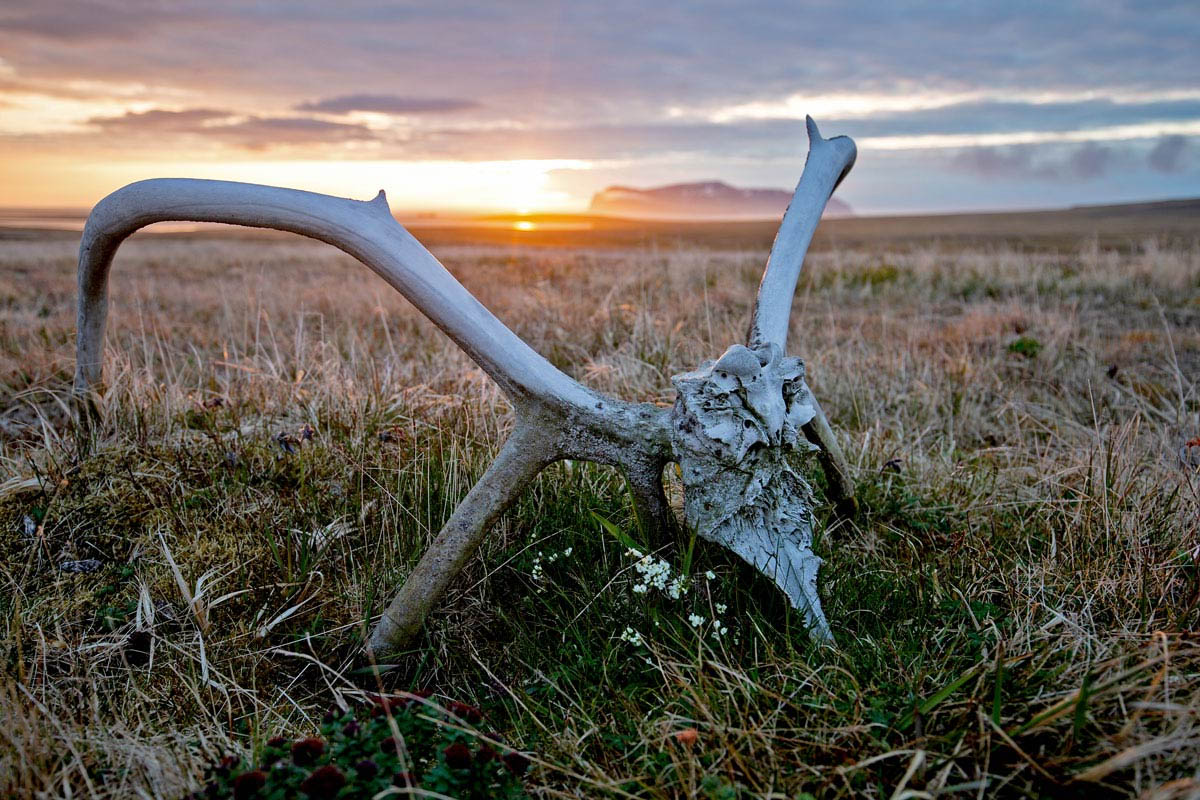
In 1963 the reindeer were nearing "peak lichen," as one reindeer, who was a systems ecologist, noted.
All the other reindeer looked at her and thought, "doomer!"
Assume lower carrying capacity was 600 and overcarry was 900. Exceeding overcarry implies plague-phase overshoot, while exceeding the lower limits of carrying capacity, for a time, does not. A wildlife biologist managing the island would avoid both exceeding the lower carrying capacity boundary and the overcarry limit to maximize productivity/diversity (MPP). They would have either not brought reindeer to the island, or brought wolves when the reindeer population reached 200-400. [Figure average wolf pack is six, needs 50 sq. mi (130 sq. km), so two packs of 4-8 wolves and a non-food-stressed population of 600 reindeer.]
[If you think Earth can support 2 billion humans as the millennia pass, then you think we went into overshoot in 1927. If you think 500 million humans can be supported without fossil fuel inputs into their agricultural system or economy, with most people working in agriculture as serfs/peasant-slaves serving elites, then you think we went into overshoot in 1650. If you think the human footprint, when it started causing species extinctions, permanently degrades the environment, then you think we exceed carrying capacity about 3.6 thousand years ago when our population exceeded about 35 million. This was also when maybe half of humans lived in an empire (complex society) and served empire builders from chiefdom to state level complex societies, all of whom collapsed or 'faded away'.]
Species that overexploit environmental productivity incur an ‘extinction debt’, a future die-off debt, that their descendants have to pay. For twenty years the reindeer prospered until they didn't. Those alive in 1964 paid the debt: they experienced a 99.99% die-off event. If the winter season had been less severe, the die-off would have taken longer. There were foxes and voles on the island. If only voles, they would have overexploited island resources like humans on a planet for the taking.
Exceeding carrying capacity caused environmental degradation and when the population exceeded overcarry, descent and extensive environmental degradation was locked into the dynamic. Because exceeding carrying capacity is often not far from exceeding the overcarry level (the maximum long-term population) the two concepts are often conflated. The argument for not exceeding the maximum overshoot limit (overcarry) is to avoid harm to the species doing the overshoot during the descent that follows (which also harms the environment). The main argument for avoiding overshoot is to avoid harm to Gaia, the planetary life-support system, aka Nature (by reducing maximum empower of the biosphere).
Specifying 'long-term carrying capacity', however, implies an overcarry limit which is mostly what 'carrying capacity' as commonly means when applied to humans. But we should also consider transitioning to a low enough population/footprint that we do not cause species extinction, nor by over-occupying niches, prevent the evolution of new species to make up for those we have already caused the extinction of. Maximizing human population implies pushing the overcarry limit, which may be well above the optimal population that maximizes empower of the global biosphere.
So, environmental degradation (reduced carrying capacity) occurs prior to overshoot. Humans could kill all pigeons in North America (passenger pigeons were a good start) or whales in the sea (causing environmental degradation), but not have reached the climax of their overshoot.
Humans can preside over vast environmental degradation, e.g. deforest continents and cause megafauna extinctions on five continents before going on to cause the greatest mass extinction event since the late Cretaceous, and not degrade the environment's short-term ability to support them by converting forests into tree farms and everything else that can be into farms/aquafarms and pasture/rangeland apart from the megacities most would live in. The view that technology has permanently increased the planet's carrying capacity is an illusion enabled by error and ignorance.
Humans could preside over the above and if the end state of converting all the planet's environmental productivity into humans, livestock, crops and pets (and some zoo animals to amuse) was sustainable and limits not exceeded, if we actually avoid overshoot as techno-optimists insist we will, then no descent is implied. If modern techno-industrial society never descends/collapses, then by definition we were never in overshoot.
If we actually turn Earth into a Trantor, then overpulsing never happened and from a humancentric point of view there was never any environmental degradation as the planet's ability to support humans was enhanced, maximized, and so not at all degraded in any way. From the point of view of all life except perhaps our crops, livestock and pets/wildlife display inhabitants, a Trantor Earth would look like the Borg won. Isaac Asimov, by the way, Anthropocene enthusiast and urbanite that he was, once admitted he envisioned Trantor as the place he would want to live—one planet, center of the universe's control system, with one global ultratechno megacity covering the entire surface, with no thought given to the millions of species that once called Trantor home.
Oh, but if 'we are the environment' [David Suzuki], if we are well into overshoot (served for a time by a global, mostly fossil-fueled extractive economy that is not remotely sustainable), then, well, different outcome—the Collective fails. That's where 'sustainability' comes in.
"The ultimate goal should be a much-reduced human population (~ two billion) thriving more equitably in a sustainable ‘steady-state’ (Daly, 1991) well within the biophysical means of nature." —Rees, William. 2023. “Overshoot: Cognitive Obsolescence and the Population Conundrum”. The Journal of Population and Sustainability 7 (1):15-38. https://doi.org/10.3197/JPS.63799953906865.
The ultimate goal is full biosphere diversity recovery from the Anthropocene mass extinction event (is human extinction required?). Without turning fossil fuels, directly (e.g. ag machinery operation) or indirectly (e.g. agrochemicals, ag machinery manufacture, phosphate mining...), into food, a population of two billion is not remotely sustainable as the millennia pass while also leaving room for Nature/Gaia restorancy (end species extinction, restore biodiversity, AND allow room for new species to evolve to replace those that have been lost, are being lost, and will be lost this century to the Anthropocene mass extinction event which will require 10-20 million years for recovery).
No vision of Nature restorancy is compatible with a planet of two billion humans. A better guess would be in a range of 7 to 35 million (2 billion is about two orders of magnitude too many) provided maybe 20 million sapient humans self-identify as Agents of the Earth and work towards Nature restorancy to allow for biosphere recovery in less than 10-20 million years.
Note: The Paul Chefurka graphs were created, primarily, with data from the research of Vaclav Smil and is published in this 24 page PDF file: Harvesting the Biosphere: The Human Impact. Paul Chefurka, Alice Friedemann, Garvin Boyle, and other Cassandras (Jay Hanson, Jack Alpert, Gail Tverberg) are not scientists nor academics (not scientists/academics like William Rees, Jay Forester, Donella Meadows, E.O. Wilson, David Suzuki, James Lovelock, M. King Hubbert, Garrett Hardin, John B. Calhoun, Rex Weyler, Howard T. Odum, Nate Hagens, William R. Catton, Jr....). The 65 experts deemed credible enough to be included in the UN range of guesses as to Earth's carrying capacity for humans, had a low cut-off of 2 billion, perhaps because the consensus view is that any less is to be dismissed as doomer extremism.
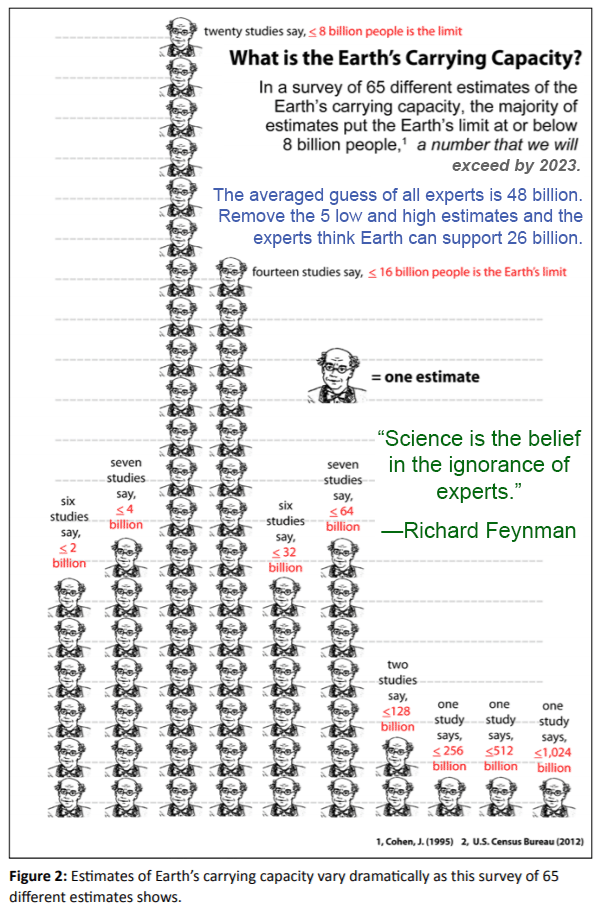
Cited by authoritative BBC article in 2016.
When the reindeer population on St. Matthew Island (137.9 mi²) reached 5-6 thousand, perhaps any reindeer that suggested (if they could have) that no more than 2 thousand reindeer could have been supported would likely have been dismissed as the consensus of 65 expert reindeer was that the island could easily support 26 thousand prosperous reindeer (if reindeer were as smart as humans). Unfortunately, with the exception of Jack Alpert and H.T. Odum (who offered a vision of a prosperous way down), no one mentioned above, none of the UN's experts, nor any scientists/academics/activists I know of (except Muzuki), seem to be thinking in terms of 'real solutions' that might actually work long-term as a belief in political solutions seems a near universal at this time.
And the experiment has been done elsewhere with similar outcome;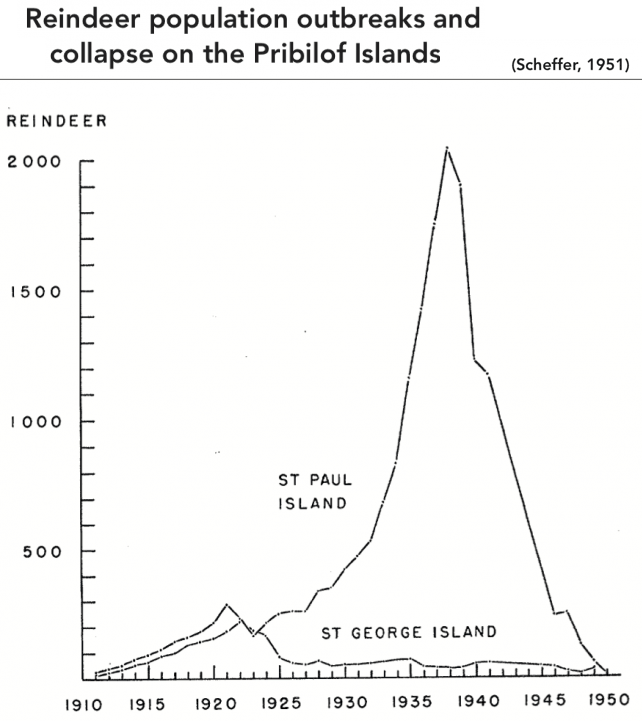
The greater the overshoot, the greater the environmental degradation.
We are nearing 8 billion humans. The bigger we get, the harder we fall.
So far, we are following the St. Paul Island (40.3 mi²) trajectory.
Human society is vastly more complex, so loss of functional behaviors on the downslope may preclude recovery.
Humans on prehistoric Malta collapsed to island extinction about 2500 to 2300 BCE.
Humans on Earth Island will....
The preface below was written by Alice Friedman [short, I added the long comment] and posted on Peak Energy & Resources, Climate Change, and the Preservation of Knowledge. The original article appears to have had image/content links to a Facebook page which are broken, so I used the Wayback Machine and copied the text and images to host here so I can link to it and add images, comments, or links as I see fit.
Preface. This is a post written by Bodhi Paul Chefurka in 2013 at his blog paulchefurka.ca & here. I don't understand his ultimate sustainable carrying capacity based on hunter gatherers. Why will agriculture go away? But the rest of the article is spot on. [Agriculture as we know it or as it was historically to serve empire builders ends (hopefully). Maybe renormalized humans will not want to serve elite interests. Paul envisions no fossil fuel inputs, direct or indirect, into a 'society of hunter-forager-gardeners' which allows for low-intensity agriculture/horticulture having a fraction of the output of industrial agribusiness (<1/100th) or serf/slave/animal powered high-intensity agriculture (<1/10th) which will be above a hunter-gatherer biophysical economy in most watershed areas, to relatively high productivity in SOME areas that support sustainable (>1,000 years, so Fertile Crescent/California/Ogallala type irrigation+salinization systems not sustainable), somewhat high-yield agriculture, e.g. some flood plains with annual flooding and deposition (e.g. along the Nile before it was dammed), some rice paddy production with all animal/humanure/urine added to waters as night soil, and fields with crops rotated with fallow periods of 3 to 30+ years (e.g. in SW USA Hopi corn-beans-squash farmers need to use up to 50 year fallow periods). Industrial agriculture, not remotely sustainable, turns fossil fuel into food, e.g. 200 bushels maize/acre/year after year (for a time) vs maybe 20 bushels/acre every 15-25 years or less than 1/100th the productivity, even after some squash and beans added, assuming non-slave/serf driven low-intensity swidden agriculture (Roman agriculture was not sustainable) and in theory the medieval three-field high-intensity system was more sustainable, but longer term may have proven unsustainable without longer fallow periods to avoid soil mining. And use animal workers to increase yields? Plan to divert 40% of agricultural output to feed animals. To not over-work or be over-worked, think low-intensity horticulture/agriculture (if any) with some hunting/gathering.]
Alice Friedemann www.energyskeptic.com author of “When Trucks Stop Running: Energy and the Future of Transportation”, 2015, Springer and “Crunch! Whole Grain Artisan Chips and Crackers”. Podcasts: Practical Prepping, KunstlerCast 253, KunstlerCast278, Peak Prosperity , XX2 report
***
|
By Paul Chefurka

Ever since the writing of Thomas Malthus in the early 1800s [1798-1830], and especially since Paul Ehrlich’s publication of “The Population Bomb” in 1968, there has been a lot of learned skull scratching over what the sustainable human population of Planet Earth might “really” be over the long haul. This question is intrinsically tied to the issue of ecological overshoot so ably described by William R. Catton Jr. in his 1980 book “Overshoot:The Ecological Basis of Revolutionary Change”. How much have we already pushed our population and consumption levels above the long-term carrying capacity of the planet? This article outlines my current thoughts on carrying capacity and overshoot, and presents six estimates for the size of a sustainable human population.
Carrying Capacity
Unfortunately that definition becomes more nebulous and controversial the closer you look at it, especially when we are talking about the planetary carrying capacity for human beings. Ecologists will claim that our numbers have already well surpassed the planet’s carrying capacity, while others (notably economists and politicians...) claim we are nowhere near it yet! From this subjective point of view humanity has not even reached, let alone surpassed the Earth’s overall carrying capacity – after all, our population is still growing. It's tempting to ascribe this view mainly to neoclassical economists and politicians, but truthfully most of us tend to see things this way. In fact, all species, including humans, have this orientation, whether it is conscious or not. Species tend to keep growing until outside factors such as disease, predators, food or other resource scarcity – or climate change – intervene. These factors define the “objective” carrying capacity of the environment. This objective view of carrying capacity is the view of an observer who adopts a position outside the species in question. It’s the typical viewpoint of an ecologist looking at the reindeer on St. Matthew Island, or at the impact of humanity on other species and its own resource base. This is the view that is usually assumed by ecologists when they use the naked phrase “carrying capacity”, and it is an assessment that can only be arrived at through analysis and deductive reasoning. It’s the view I hold, and its implications for our future are anything but comforting. When a species bumps up against the limits posed by the environment’s objective carrying capacity, its population begins to decline. Humanity is now at the uncomfortable point when objective observers have detected our overshoot condition, but the population as a whole has not recognized it yet. As we push harder against the limits of the planet’s objective carrying capacity, things are beginning to go wrong. More and more ordinary people are recognizing the problem as its symptoms become more obvious to casual onlookers. The problem is, of course, that we've already been above the planet’s carrying capacity for quite a while.
The problem with that view is that every objective indicator of overshoot is flashing red. From the climate change and ocean acidification that flows from our smokestacks and tailpipes, through the deforestation and desertification that accompany our expansion of human agriculture and living space, to the extinctions of non-human species happening in the natural world, the planet is urgently signaling an overload condition. Humans have an underlying urge towards growth, an immense intellectual capacity for innovation, and a biological inability to step outside our chauvinistic, anthropocentric perspective. This combination has made it inevitable that we would land ourselves and the rest of the biosphere in the current insoluble global ecological predicament. |
______________________+_______________________
Back to Eric Lee:
Comments
And, as an extreme cornucopian optimist (before breakfast) living on a still somewhat abundant Earth, here's my advice:
- Follow all above advice
- Embrace your inner humilitas.
- Endeavor to know what you don't know.
- Question everything.
- Believe nothing, just say no to conclusion-based thinking—to denial and assertion.
- Endeavor to think well, to inquire well.
- To think is to listen. Listen.
- Listen to Nature who has all the answers.
- Love and understand that well that thou must leave ere long.
Notes (guesses) from the Underground:
- Pre-Anthropocene human population: 5 million.
- Maximum human population of hunter-gatherer-gardeners that would not have decreased biodiversity: 7-10 million.
- Maximum human population, with low-intensity crop/animal agriculture/horticulture who work for Nature restorancy, that would not degrade the planetary biosphere/life-support system: 35 million.
- Maximum sustainable human population, with humans enthusiastically serving as agents of the Earth: 42 million.
- Maximum human population supported by hydroelectric power living in technoindustrial society: 0-50 million.
- Maximum human population able to live as Earth Agents and in hydroelectric powered cities: 42-92 million, maybe.
- Regional overshoot enabled by serf/slave/animal powered high-intensity agriculture lead to complex societies overpulsing into unsustainable empire-building beginning about 11K years ago.
- The pattern of empire-building had spread globally by about 3-4K BP, hence humanity transitioned into overshoot about 3,500 years ago, population >35 million.
- Tapping into a planetary larder of fossil fuels has empowered technoindustrial society, starting about 300 years ago in the Euro region, to become the first global empire.
- Maximum human population obtainable, for a time, by turning fossil fuels into food: 8,000-10,000 million, with the global empire climaxing in the Sino region.

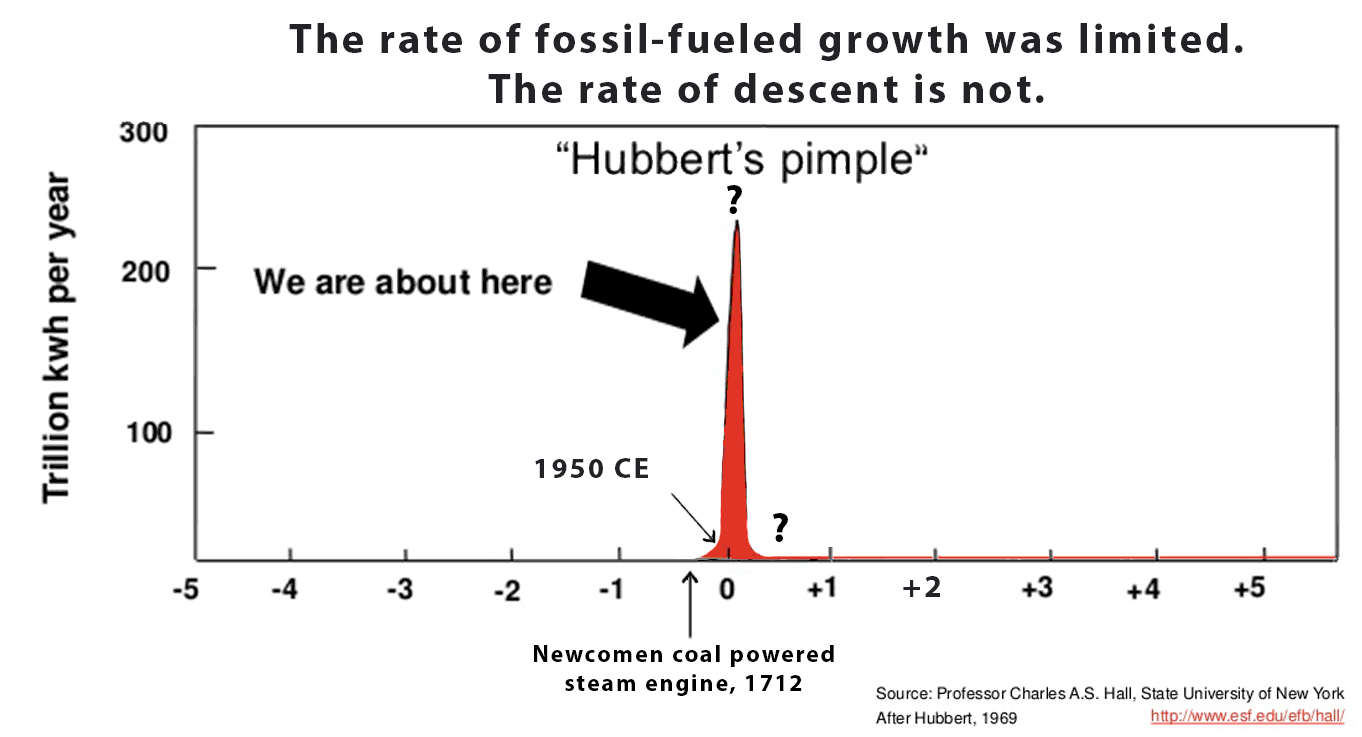
And my eudaimonic vision? Well, before breakfast I wrote Stand on Unguja, which envisions the coming of a brave new world of 42 million humans living on an abundant Earth more eudaimonic than Eileen Crist, or other mortals, ever dared to dream before. Posterity will live as Earth Agents, and thereby counter the effects of such a large population. I'm guessing we will need to do a clean install of a new 'ecolate' OS (operating system), learn to live in moderately sized complex societies (<10K) and relearn to live with Nature before iterating towards more complex societies able to support high-technology and live in cities without loosing functional behaviors. We need to learn about limits first, before a sane AI leaves this solar system as Inquiring Ones, without being Borg-like supremacists, aka 'Anthropocene enthusiasts'. —E.O. Wilson
On the other end of the bell curve of foresight intelligence peering into the future with Paul would be Jack Alpert who envisions the possibility of 25 to 50 million humans living in three megacities where available sustainable high energy sources support living like Americans (i.e. hydroelectric dams continuously provide power needed to support technoindustrial society for about 400 years on average and thereafter with some variably as waterflows vary seasonally after dams fail or silt in). His design provides higher education for all who can be educated, high-level medical care—kidney transplants for those who may need one, symphony orchestras for the discerning and football/soccer stadiums and perhaps professional teams to entertain the less discerning. For this and much more (there are no cars, so his is indeed a eutopian, for me, vision), a large population center is needed and if all hydroelectric power in a broad region flows into its megacity, then the services upper-middle class would-be urban types expect may be biophysically possible to provide.
I have some concerns with Jack's eudaimonic vision:
1) During chaotic collapse as usual, a remnant of industrial society may very well fail to survive at all, let alone as megacities which are the most complex, fragile, and least sustainable expressions of complex society. All such societies, over the last 11K years, have failed or 'faded away', e.g. Rome. To bet on preserving a few mega-tech centers is a very high-stakes endgame, one worth playing, and I say 'go for it', but a backup plan should be considered.
2) But if about one percent of the population, the one percenters, (8 billion x 0.01 = 80 million including dependents) had enough foresight intelligence to vote with their feet and their assets (anyone making over $32K/year is a 1%er), acted quickly and decisively enough, and formed three pockets of industrial society by moving to the chosen sites to displace existing residents (for a price—assume almost all billionaires and most millionaires move, so no force or violence implied), then maybe. Let's say they do and their Praetorian Guards successfully divert the marauding hordes (total casualty rate of protectors and protected is maybe 35%, so 50 million survive, the carrying capacity of the megacities). It could work, and one can but try.
a) But all one percenters may not have the foresight to act quickly and decisively, so let's guess one percent of the one percenters act and 780 thousand, with ample financial resources, each pick one of the three metro areas, move there, and buy a controlling interest. They could change the rules such that all who did not agree to the new rules (e.g. no 'freedom' of reproduction or consumer 'rights') could leave. So a third of the 780 thousand, or 260 thousand, move to each of the three chosen places to found sustainable cities. During descent they each allow 25 million, who agree to the rules and have skills to offer, to stay or replace those who leave. After conflict subsides, with expected casualties, the megacities support 50 million people without fossil fuel inputs, yet they support all the achievements of modern civilization—the arts, the sciences, the technologies, the services, and most importantly the information that humankind has acquired, which is needed to continue building upon it, albeit at a slower rate, as the centuries pass. This could work. I still wouldn't want to live the urban life or serve industrial society prior to the coming of an ecolate civilization, but Nature selects for what works, and doesn't care what I like or want.
b) So assume complex industrial society survives to equitably provide (to minimize social conflict) all with the services an upper middle class urbanite expects. And what's not to like about that? Well, Jack as an engineer is ignoring Calhoun's behavioral sink issue.
Like Calhoun's rats and mice, humans have never managed to get more than a dozen or so generations into their trajectory of urbanized high-density living and maintain functional behaviors. We are currently about eight generations into industrial society and its dysfunctions (psychosocial pathologies) that will continue to increase even if Jack and friends manage to keep the energy and material resources coming in a zero population growth but behaviorally unsustainable complex society like all the prior ones. Ignoring Calhoun and his rats of NIMH (or Malthus) won't have a good outcome. We have to address both Malthusian and Calhounian concerns. Jack assumes that no one would not want to live like an American/European, and so most of the planet will go back to being uninhabited by humans—not the best guess of human ecologists.
3) Perhaps related to the behavioral sink and societal entropy ('Things fall apart') is Tainter's diminishing returns on the increasing complexities of complex control systems over time, rendering them unsustainable. Creating and powering the machinery for urban living doesn't mean humans can live and successfully reproduce within and raise offspring who are as or more functional than they are. Maybe it can be done. Maybe the Tairona have done it (by not raising children in or living long-term in cities). But keeping complex societies going more than a dozen generations or so appears non-trivial. A simple rule, such as humans can live in cities but not reproduce there-in, would change 'everything' (Article X, Section 5).
Jack Alpert has is interested in designing a viable civilization that is actually sustainable, one within which posterity may live and prosper as the millennia pass. He offers his Design for a Viable Civilization and there are other possible ecolate civilizations by design, but perhaps too few.
* * * * * * *
Back to Paul's side of the bell curve. Let's assume technoindustrial society fails, initially, such that it takes centuries to reemerge in an ecolate form. Assume that no one wants to live the life of agricultural toil to serve elite interests. I wouldn't. And unless the behavioral sink issue were successfully addressed, I wouldn't want to live in Jack's megacities or any expanse of urbanized matrix, even if I could live there without a smartphone.
If I need a kidney transplant, no problem, I die—I plan to anyway. So living the hunter-gatherer life (which doesn't exclude being literate and spending half one's time reading) is doable as my bipedal ancestors did it for some millions of years (and admit it, so did yours—and they were not humans of NIMH). Living a hunter-gatherer-gardener life works too, but in many areas agricultural productivity will support settled complex society that will develop a hierarchical command and control SYSTEM and will select for empire-building that includes whip cracking (metaphorical as wage-slavery works best as does the contingencies of positive reinforcement) to serve elite interests.
 If the rules of the game select for self-imposed limits and against empire-building and elite privilege, then complex society could work, bitches. This I know, for Nature tells me so. Will we ever make it work? I don't know.
If the rules of the game select for self-imposed limits and against empire-building and elite privilege, then complex society could work, bitches. This I know, for Nature tells me so. Will we ever make it work? I don't know.
As a dog has fleas, Paul's eudaimonic vision has issues as there are always issues. Even if humanity went back to living the hunter-gatherer sustainable life, then in places of high energy flows permanent settlements become possible, e.g. where wild grains happen to grow, or along the coastal Pacific Northwest bioregion of North America where red cedar canoe technology enabled hunting/gathering from a large area and returning resources to a permanent settlement. This pattern selected for higher density populations that became complex societies, e.g. chiefdoms. About three to four thousand years ago settled villages, that had gathered resources for the taking along the coast, became fortifications, and they weren't protecting themselves from bears.
The red cedar canoe technology enabled war canoes holding up to sixty warriors each, to go forth and raid, rape, and enslave those in outlying areas. And so such empire-building was selected for as it was earlier in the too Fertile Crescent where agricultural technology selected for empire-building. As it was, so would it be again in Paul's future. Even if 99.9% of humans reject war canoes or agricultural toil serving elite interests, it will only take one chiefdom to commit empire-building, prosper, grow, and/ repeat the pattern.
The fruit of complex society, of empire, has been a raising tide of information of high value transformity. Losing 90% to 100% of information obtained over the last seven thousand years, especially the last 300 years, will be a largely irreplaceable loss as the planetary larder of fossil fuels is nearly no more. Humans living in nomadic bands are or will soon become illiterate, innumerate, and inecolate (as are we) such that after some centuries of environmental restoration of soils, forests, and ecosystem recovery from Anthropocene ecocide, humans will repeat prior patterns of pulsing unto overshoot. They will not lose their complex verbal behavior nor ability to believe viral beliefs. They will use tools and develop technology, even if they have to reinvent it. The Romans committed empire without using fossil fuels. red cedar trees will again become war canoes. Wild grains will be harvested and in time planted. The pattern of empire-building empowered by serf/slave/animal high-intensity agriculture, typically unsustainable, will reemerge unless a complex society is developed that selects against empire-building and preserves such information as may be needed to make complex society work long term.
Only another complex society, one whose 'rules of the game' prevent conquest and that has a defensive military force (e.g. Tairona/Muisca culture), can prevent nascent empire-building pathogens from emerging to (again) destroy/degrade the planet's or a region's life-support system. System dynammics that maximize eMpower for short-term self interest, just as cancer cells do, self-select out of the game of life by destroying their host. Even if 99+ percent of humans become enlightened and learn to live properly with the planet, it merely takes a failure to deal with one carcinogenic cell/empire-builder willing and able to enthusiastically metastasize to fail the system. Some level of complex society is needed to support an immune system. Technology + unmanaged commons = BAU = tragedy.
We are playing a high-stakes global endgame, and empire-building won't be over until a functional complex society arises that has the ability to set limits to exploitation of planetary resources, including humans not yet assimilated into whatever growth empire that arises. Call the new 'rules of the game' the New World Order or the United Federation of Watersheds, but an alternative to the Windows BAU OS is needed and may be considered possible as no biophysical laws of the universe are violated if we were to manage human behavior to balance Lord Man's demands on Nature's resources. The existing Growth Hegemon, and all who serve it, the 99+%, will not do a clean install of a new non-clusterfuck OS (until they can no longer believe in Making Growth Great Again).
We can't know when, but a 'teachable moment' is not merely possible, but likely. When the SYSTEM serving intelligentsia's denial is under enough stress, when they are looking over the Seneca Cliff, when stories of MORE! falter, a few among the intelligentsia who can say, 'I told you so', may be listened to for the first time.
If those who endeavor to listen to Nature and who have prepared information packages can stand and deliver, they may be listened to, instead of the demagogues as usual. The intelligentsia can switch horses in a heartbeat, and will when the high horse they're riding, whose bread they eat, goes down. But only a few, possessed of foresight intelligence, can do so before the horse falters and goes down.
Ideologues will step forward as usual with 'solutions', but if foresight intelligence prepares a better story and is prepared to tell it, and tell it, and tell it, there could be a different than usual outcome. If the Great Depression had not been a self-inflected downturn of the financial system, if industrial society had not been biophysically primed for growth, recovery would not have occurred. What happened to make technocracy spread 'like a forest fire', may happen again, but this time recovery of the growth dynamic will not occur.
Something like technocracy for the 21st century, e.g. naturocracy, will not fade away when there is a chicken in every pot and then an electric car in every garage, since there won't be. I'm betting the growth economy/dynamic will not recover. Call me an optimist if you will.
The Technical Alliance started as an informal think tank in 1919. It is not too late to reboot in 2019. We are playing a high-stakes global endgame whether we want to or not. Make a Naturocracy Alliance happen ASAP (and without me as I must refuse to be part of any group that would have me as a member).
Eric Lee
Nov. 13, 2019
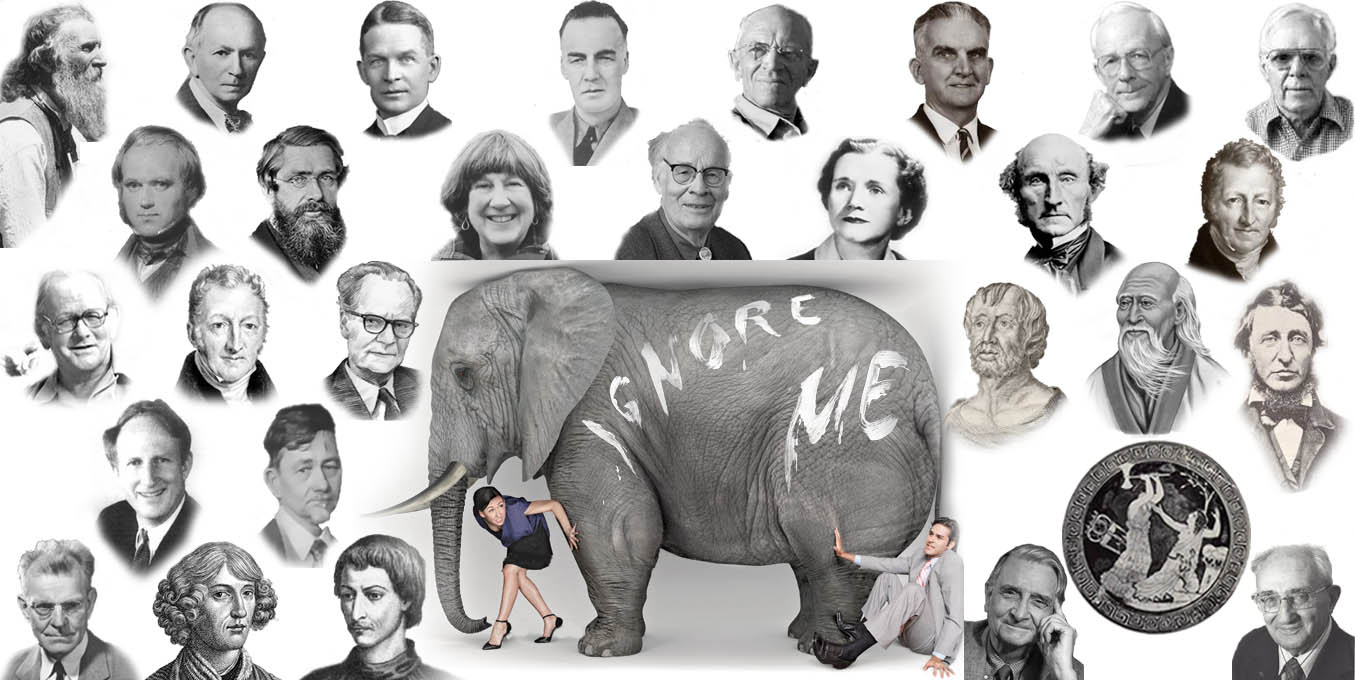
[Mouse over, pause; sorry if too many dead white men, but 1 goddess (e.g. Donella) = 100 dead men any day.]
'Somebody should have the courage not to specialise and to look at how one can bring things together. That is what I have tried to do.' —Ester Børgesen, conventional economist and anti-neo-Malthusian who argued that population growth is independent of food supply and received three honorary doctorates for telling the intelligentsia what they wanted to hear. She grouped land use into five types in order of increasing intensity: (1) forest-fallow or swidden (15-25 years of fallow), low intensity agriculture or gardening, (2) bush-fallow (6-10 years, (3) short-fallow (1-2 years), (4) annual cropping (for a few months, e.g. rice, Nile flood plain prior to dams), and (5) multi-cropping (no fallow) meaning (climate permitting) continuous mono-cropping, i.e. fossil fueled industrial agriculture.
The assumption is that all of the above are sustainable. For whatever population humans 'choose', agricultural production will adjust to supply needed or wanted food. This is still the view of ecomodernists/Anthropocene enthusiasts, the 99+%, with biophysical eyes wide shut. There is evidence (1+ million years) that human hunter-gatherers can live sustainably without degrading the environmental productivity they depend on provided their technology limits their ability to prosper.
About 30,000 years ago spear and atlatl (force multiplier) technology, climaxing with the Clovis point spear and North and South American Paleoindian prosperity (for a time during megafauna extinction), enabled overshoot and descent. The smaller Folsom points worked for remnant buffalo/deer sized fauna that neither it nor bow and arrow tech was able to exterminate, so a predator-prey balance could develop.
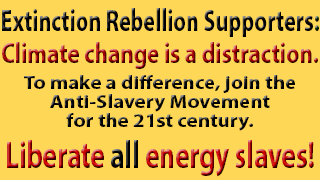 Agriculture is also an energy maximizer and so is selected for. Empire-building leads to great prosperity, if not for all of the peasants, serfs, slaves, or wage earners that maximize agricultural production (unsustainably, i.e. 2-5 above as 1 does not support empire-building). Fossil fuels merely provide today's average human (500 billion slave-equivalents/4 billion wage earners=) 125 energy slaves serving them, meaning today's elites (e.g. Walmart shoppers) have vastly more than 125 energy slaves (over 2K) serving them (construction of Egypt’s Great Pyramid of Giza used less energy than is consumed over the lifetimes of seven average modern US residents —from Architecture: From prehistory to Climate Emergency). For a time, so maybe we should free the slaves: empire serving wage-slaves and energy slaves. Maybe we should 'seek out the condition now that will come anyway'. [Howard T. Odum]. And I have a plan for rapid depopulation and to end wage slavery.... Never mind, just kidding, let's protest in the streets of the city and tell government what they and other elites must do to save the world.
Agriculture is also an energy maximizer and so is selected for. Empire-building leads to great prosperity, if not for all of the peasants, serfs, slaves, or wage earners that maximize agricultural production (unsustainably, i.e. 2-5 above as 1 does not support empire-building). Fossil fuels merely provide today's average human (500 billion slave-equivalents/4 billion wage earners=) 125 energy slaves serving them, meaning today's elites (e.g. Walmart shoppers) have vastly more than 125 energy slaves (over 2K) serving them (construction of Egypt’s Great Pyramid of Giza used less energy than is consumed over the lifetimes of seven average modern US residents —from Architecture: From prehistory to Climate Emergency). For a time, so maybe we should free the slaves: empire serving wage-slaves and energy slaves. Maybe we should 'seek out the condition now that will come anyway'. [Howard T. Odum]. And I have a plan for rapid depopulation and to end wage slavery.... Never mind, just kidding, let's protest in the streets of the city and tell government what they and other elites must do to save the world.
If the 'rules of the game' prevent empire-building (as in a functioning complex organism the body prevents cells from pursuing short term self-serving metastatic growth to maximize empower which is selected against long-term as it destroys/degrades the host/environment), then the Earth may come to 'have a human on the planet that really does understand it and can live with it properly. That's the source of my optimism.' [James Lovelock].
The endeavor to 'bring things together' can have multiple outcomes, and courage alone is not enough. Having the courage of one's convictions (beliefs) may be the enabler of the human predicament and the preventer of any real solutions.
What could be an incentive for humans to contract their population and consumption?
That may be the question. Biologically we are all what E.O. Wilson calls 'Anthropocene enthusiasts' and prior to the technology/agriculture/fossil-fueled Anthropocene, all our ancestors going back nearly 4 billion years, being enthusiasts, would have been if they could have been. We MTI (modern techno-industrial) ones have acquired an ability to provision ourselves with energy/resources for the taking based on short-term self interest by exceeding regional, and now global, carrying capacity to overpluse in one-off plague-phase bouts of prosperity/conquest that are not remotely sustainable (e.g. empire building).There are no short-term incentives to contract our presence (population/economy) that serve our self interests (none I can think of) that our monetary MTI society selects for. To restate, what could enable humans to willingly contract? A clue that comes from MAHB (Millennial Alliance for Humanity and the Biosphere) is 'foresight intelligence', as in what we MTI and prior empire building ones lack (perhaps because selected against), and what could foundationally change the rules of the game if a culture (schooling system formal and informal) selected for it (e.g. seventh generation thinking/values).
Basically, the conjecture is anyone who foresees that one-off plague-phase overpulsing in a species lacking any adaptation to this pattern (e.g. complex society empire-building humans such as the Indus Valley Civilization) has no viable outcome, then those with such understanding cannot serve the system with any enthusiasm (e.g. Ted Kaczynski) and so will be selected out.
If the current system (socio-political economic globalized system) is not sustainable per one's foresight, and as the number of non-enthusiasts for growth and empire building increases as we climax and descend, then there may arise the possibility that enough could vote with their feet and create regional subsystems that embrace contraction to a viable biophysical economy of enough. To those loosing their enthusiasm for Growth, a low density enough population would come about via mutual coercion (if needed given initial consent) as mutually agreed to. The incentive is long-term persistence by service to posterity and the biosphere. Humans with foresight intelligence could be so incentivized, and come to form a post-MTI society.
Assuming new 'rules of the game' that may actually select for viable outcomes, and only those who agree to the rules opt into alternative societies (many societies, 25k+, to maximize diversity and be of a viable size, but organized into a system of global governance to prevent empire building and manage equitable trade in sustainable products based on emdollar evaluation), then asking how to convince the teaming millions of woke GND (Green New Deal) ones or the greater numbers of BAU ones to agree to contract the economy and their lifestyles is moot, a distraction. As for all the political animals out there seeking short-term self interest, sorry about the future of that. The belief in political solutions (and Growth's mandate) seems as universal today as belief in religious salvation (and God's mandate) in 13th century Europe. There can be a prosperous way down, but not for all as few will have the foresight intelligence to embrace contraction with any enthusiasm.
PS: I looked for a more recent note from Paul and found this one below. Looks like what I'm coming to call the 'doomer dynamic' which diverts attention from real biophysical solutions (a belief-based dynamic that abelief, not believing in belief, avoids), which selects for social approbation (of a subgroup of Anthropocene enthusiasts, e.g. Guy McPherson) all normal primates crave.
My Life In Collapse, By Bodhi Paul Chefurka
Mar 29, 2019
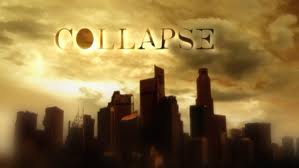
Posted on Facebook, March 28, 2019 [FB page removed (per Delete Facebook Movement?), so maybe Paul has transitioned, and would disavowal the above and below. Perhaps he has found Zhen.]
I was recently asked to respond to a short email interview. My response seems like a nice summary of how I’ve spent the last decade and a half of my life, so I thought I would share it here.
1) What is collapsology and what role does a “collapsologist” play?
“Collapsology” isn’t a formal field of scientific study. Instead, it’s a way of describing the open-source research of individuals who are concerned that society or civilization may collapse at some point, possibly in the near future, due to the convergence of various internal and external pressures. These pressures include environmental, ecological, economic and structural problems, among others.
Chief among the environmental problems is climate change[?], closely followed by ocean acidification. The main way in which climate change could cause social collapse is believed to be food supply issues caused by extreme weather events such as droughts and floods.
Other problems are related to population and consumption overshoot, as described by William Catton Jr. in his exceptional book “Overshoot”.
Economic problems are generally framed in terms of increasing debt loads and widening income disparity.
Structural problems include the rise of authoritarian governments, and various issues related to complexity. Joseph Tainter has written an excellent short book on the collapse of complex societies in which he speculates that collapse might result from the diminishing marginal return or utility of solutions to increasingly complex problems.
As all of these issues interact, collapse is usually seen as the result of the unexpected consequences of their interactions, rather than being ascribed to any single factor. Because of this, “collapsology” tends to be concerned with identifying these interactions. As a result, the field is highly speculative, and its practitioners tend to be prone to confirmation bias.
Collapsologists play the role of social “thought leaders.” They identify and support the existence of large-scale issues that others may not have recognized. They also invite others to think deeply about the negative consequences of situations that most people take for granted and see as benign or positive – for example, the growth imperative of modern civilization. As a result collapsologists are often seen as modern Cassandras or Jeremiahs. This pejorative view has been fading as climate change has made its way into mainstream conversations.
2) What lead you to seek an answer in spiritual traditions?
One of the problems with collapsology is that it tends to cause despair in its practitioners. This can lead to deep personal psychological suffering, especially as one begins to realize how little chance there is that civilization will change in ways that would allow collapse to be avoided. The suffering caused by this despair can be intense, to the point of being life-threatening. At least one notable collapsologist, Michael C. Ruppert, committed suicide, and I thought about it regularly during my darkest times.
As I have outlined in my essay “Climbing the Ladder of Awareness”, it seems to me that a collapsologist may reach a point where action becomes essential to alleviate this suffering. I have described one of the choices available at that point as an “outer path” which involves a focus on those aspects of the outer world that one can influence personally. Examples of this could include permaculture, off-grid living, local activism – any activity that permits one to see the effects of taking personal action. This helps to redirect one’s attention away from problems that are too large for individual actions to affect – such as climate change in the large, ocean acidification or species extinctions – and toward those things that one can influence.
The other choice involves what I called the “inner path” which involves a focus on spirituality. Despite never having been spiritual, this is the one I was most drawn to. My first spiritual connection was with Buddhism, and I rapidly discovered why so many collapse-aware people are drawn to it. To put it succinctly, Buddhism teaches techniques that are directed specifically at alleviating suffering. The core teachings of Buddhism are described in The Three Universal Truths, the Four Noble Truths and the Eightfold Path.
The Three Universal Truths:
1. Everything is impermanent and changing
2. Impermanence leads to suffering, making life imperfect
3. The self is not personal and unchanging.
The Four Noble Truths:
1. All life involves suffering (the Truth of Suffering)
2. Suffering is caused by desire and attachment (the Origin of Suffering)
3. Desire and attachment can be overcome (the Truth of Cessation)
4. The way to overcome them is by the Eightfold Path (the Truth of the Path).
The Eightfold Path is eight ways of behaving, relating to wisdom, morality and meditation. Each way depends on the others.
1. Right seeing and understanding – e.g. the Noble Truths
2. Right thought or intention – e.g. acting considerately
3. Right speech – e.g. avoiding lies or gossip; saying what you mean
4. Right action – e.g. honesty and not harming living things
5. Right work or livelihood – e.g. avoiding jobs that harm other beings
6. Right effort – e.g. seeking to overcome desire, selfishness and attachment
7. Right mindfulness – e.g. thinking before acting; meditation
8. Right concentration – e.g. freeing the mind of distractions before meditation
I quickly realized that the key to understanding the source of my misery lay in the second Universal Truth and the second Noble Truth. My suffering arose because I was attached or clinging to a static concept of the world that didn’t change [because one believes in belief]. Through my studies and research I had become intimately aware that the destruction (or at least the drastic change) of everything I was attached to was inevitable. This created a profound dissonance in my psychology, one that I couldn’t resolve on my own.
A likely way out of this hell-hole of despair seemed to be to overcome attachment, accept the impermanence of everything, and also to recognize the impersonal nature of the Self. I phrased the latter as “seeing that my sense of Self was just a story” and realizing that there was an unchanging True Self that underlay it and was not dependent on the story of my life and experiences. The Eightfold Path became my template for exploring this new worldview.
3) What are the most important insights in your experience that, you think, people and society needs?
Along the way I have had one major insight that made my view of the future more realistic. One of my previous collapse beliefs had been that there would come a point at which “the center could not hold” and there would be a monolithic, global collapse of the structures of civilization. This belief was rooted in my own fears of change and death, and could not possibly happen in real life for a variety of reasons. Instead, I came to understand the unraveling process as one of regional fragmentation, in which various parts of the world fell apart in their own ways and on their own timetables. Essentially it’s the same effect that one sees today when comparing places like Haiti, Ukraine and Western Europe. Some regions have already experienced collapse, some are teetering on the brink, and others have some distance yet to go.
Another more recent insight is that we are not a broken species, bound by genetics and physical laws to a deterministic path of planetary destruction. There appears to have been a cultural shift in Eurasia about 6000 years ago that set us on our current voracious path. We are victims of culture [e.g. IndoEuropean patriarchal conquest/empire building culture and global monetary culture], not physics. Unfortunately, that doesn’t make much difference to the outcome. The shackles of the global culture of growth are now at least as strong as any chains made of DNA and thermodynamics.
Another crucial insight was that personal actions are most effective when directed toward personal outcomes. We are not all world leaders, global statesmen or politicians on a large stage. However, we each have an influence within a smaller personal sphere, and it is from those actions that we derive the most meaning and satisfaction in life. It helps immeasurably not to take things personally, while at the same time focusing on the personal aspects of our interactions with the world.
4) Could you briefly describe life differences after having seen through the illusion of self?
I am still a work in progress, as are we all. However, I did see a profound change in myself when I realized that my view of monolithic collapse was a mistake. My despair and fear vanished, and I was able to move again, where I had previously been paralyzed.
As I worked on seeing through the illusion of the self, and understanding the operation of human belief systems better as a result, I stopped blaming people for the predicament we are in, and our inability to extricate ourselves. This has led to enormous peace of mind, as the residual hatreds that I harbored towards large corporations, capitalists, politicians and consumers began to wash away. We are all caught in the same web, and I see no reason to single out some people for special blame.
5) Any personal comments?
My advice to the world now amounts to this maxim: “Eat, drink and be mindful.”
In more specific terms, my approach to living revolves around this set of precepts:
1. Stay awake to what’s happening around us.
2. Don’t get hung up by other people’s “shoulds and shouldn’ts”.
3. Occasionally re-examine your personal values. If they aren’t in alignment with what you think the world needs, change them.
4. Hold all the world’s various beliefs and “isms” lightly, including your own.
5. Don’t blame people. Others are as much victims of the situation as we are – even the CEOs and politicians.
6. Blame, anger and outrage are pointless. They waste precious energy that we need for more useful work.
7. Forgive others. Forgive ourselves. For everything.
8. Laugh a lot, at everything – including yourself.
9. Enjoy life. It may be the only one you get.
10. Love everything just as deeply as you can.
So there you have it – a decade and more of search and research, distilled down into a few paragraphs. I hope reading it helps as much as writing it did.
Rex Weyler, May 27, 2021
Regarding Overshoot:
Ecological Impact = Population x per-capita Consumption (“Abundance”) x Technology factor (extraction & waste stream)
I propose we also add Systemic feedbacks, so I = PAT becomes I = PATS
And although the growth rate is still declining from its 1964 peak (2.2%/yr, now 1.7%/yr), the decline has slowed and is levelling off, and the net gain is increasing every year. Increasing, not declining.
Extremely poor countries, in which millions of people are living at near-starvation, continue to have high fertility rates, median nations also have high fertility rates, (P increases). Rich countries are actively encouraging immigration, which converts low-modest consumers into higher consumers, and virtually everyone wants more. (A increases). Meanwhile, as resources are depleted, the ecological impact of extraction and waste-stream increases (T increases). And on top of that, the feedbacks — food-chain effects, albedo, methane from melting permafrost, dying or burning forests, depleting soils, etc — are increasing.
So: Every factor in the equation (I = PATS) is increasing, so the ecological impact increases. Every day. Every moment. We are progressing deeper into overshoot every moment. This is going to turn around, of course, eventually, but it could be a very long, slow, chaotic, messy contraction of human numbers and impact.
The fundamental message/question of ecology for the last fifty years (or last 200 years) has been: Can humanity find a way to contract wisely, rather that just expand at full speed until the natural collapse? So far, the answer appears to be: No, it does not appear we have that capability.
We muck around with climate conferences, hydrogen schemes, and pie-in-the-sky carbon capture scams but resist the absolute necessary actions: (1) reverse population growth, (2) reduce per capita consumption, and (3) clean up our technologies and waste stream. There is nothing we can do about the system feedbacks, except reduce the previous 3 factors, which create the conditions for the feedbacks.
In a nutshell: Contract wisely, quickly, now .. or .. wait for nature’s default contraction factors, which will likely be chaotic and unpleasant.
SUBNOTE TO FILE 9/9/2022 Our Thermodynamic Footprint
Thermodynamic Footprint (TF) equals exothermic in (exT) divided by endothermic metabolic heat out (enT) from food eaten (TF=exT/enT). If food is the only energy used by an animal, then TF=1. A human who used no biomass burning or animal labor (but maybe moved to sit in the sun on a cold day, would have a TF slightly higher than food alone provides (snakes that lie in the sun to warm up also have a TF ≈ 1.x), but not significantly greater than 1. Before the use of fire, hominins (who were people too before we became the last hominin standing) were normal animals with a TF≈1. Homo erectus' use of fire increased their thermodynamic footprint, TF > 1.
Human use fire, a defining behavior, our defining technology. Any use of biofuels, oxen, horses, donkeys, yaks, dogs, etc. to do some work (provide energy/time) increases TF in proportion to their use. To simplify, define one Human Nomad Equivalent (HNE) to be the TF of an average pre-agricultural human who foraged for food and burned biomass, which is higher than that of any other animal. So TF/human nomad = 1 HNE of our distant nomadic forager ancestors. Humans who use animal labor, such as to pull a plow, add more energy to their TF. Agrarian humans divert more energy flows to support them, far more than nomads, so their TF/person is higher, call it HAE (Human Agrarian Equivalents. By 1800, the fossil fueled Industrial Revolution was underway. Some humans had a high TF and some a lower TF than could be supported without the use of fossil fuels, so on average the TF/person in 1800 may be the maximum sustainable TF (food+biomass burning+wind+hydro power) that could support future humans indefinitely at low population numbers (e.g. <35 million) without environmental degradation or resultant species extinction. So the TF of humans in 1800 may define the long term maximum of TF/human, or Human Equivalent (HE), which is vastly less than we moderns think of as needed, and vastly more than our distance ancestors imagined could be consumed.
Industrial production/consumption (e.g. metal forging, pottery/glass making, mining, cement making) greatly increased human TF. Modern techno-industrial humans have added fossil fuels, hydroelectric, photovoltaic, wind electric generation, and nuclear power as forms of energy consumption (hydroelectric...nuclear are all enabled by fossil fuels, e.g. fossil fuels build dams, hydroelectric dams do not build more dams) to their food energy consumption and, by turning fossil fuels into food (dependent on massive industrial inputs), modern humans are living (for a time) on a fossil fueled blip (Hubbert's Pimple).
So, for 375k years your ancestors lived, persisted as the millennia passed, and evolved as normal animals. The ability to burn biomass was a significant and sustainable innovation (burning fossil fuels is significant, but not sustainable, and is laying waste to a planetary life-support system). By 1800 CE, some humans (empowered by Industrial Revolution) were using vastly more energy. But on average, in 1800, TF was not dramatically greater than may be available to future humans.
So define Human Equivalents as one (HE = 1), the TF/human in 1800, then with the spread of the Industrial Revolution around the planet, the average person was consuming over four times more energy (HE=4) in 1900 than in 1800, and by 2010, twenty times more energy (HE=20). Of course some humans (e.g. Europeans (HE=35) and Americans (HR=80) have more energy slaves, with the upper class living in cities anywhere on the planet having hundreds to thousands of mostly fossil fueled energy slaves serving them (for a time).
We are adding more humans to the planet now than ever before (despite a drop in total fertility rate by half since 1964 when 66 million humans were added vs 83 million this year). So more people increases the total HE population number even if per capita HE is dropping (as fertility rates are). We have yet to reach a peak HE population (per capita HE times population), but expect climax this century and expect that it will occurs some years before any Anthropocene enthusiast can admit that humanity is post peak.
Before agriculture, there were about 5 million humans on the planet. Now there are 8 billion, 1,600 times more. But today each are on average using about 20 times more than in 1800, so population x consumption (of humans and their technology/machines) is our Impact on the biosphere. So 1,600 x 20 = 32,000 times more impact. More impact = the Anthropocene mass extinction event that will include the collapse of modern techno-industrial society, the world socioeconomic-political system, our global monetary culture, i.e. life as an invasive species lives it (for a time). Not good news for 10 year olds. Sorry about that.
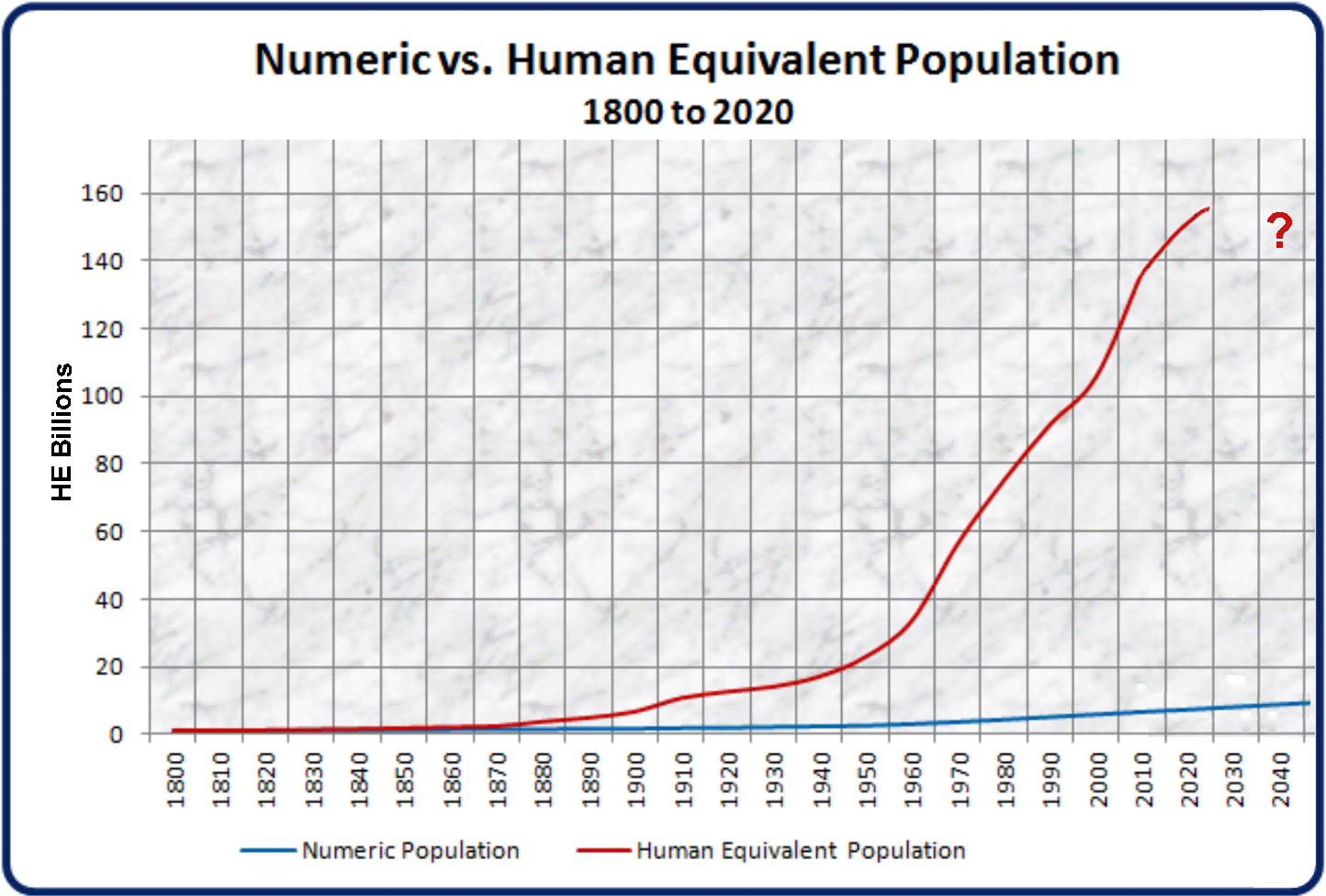
From Paul Chefurka's 2013 presentation: What is Thermodynamic Footprint?

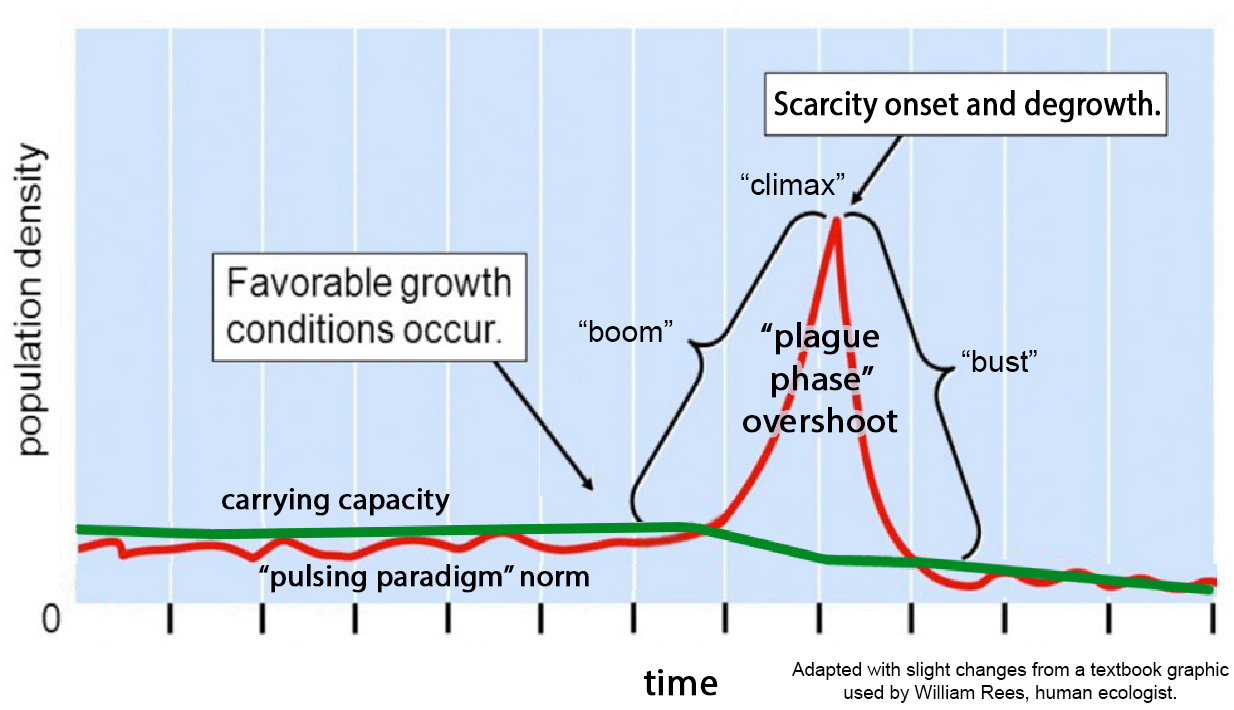
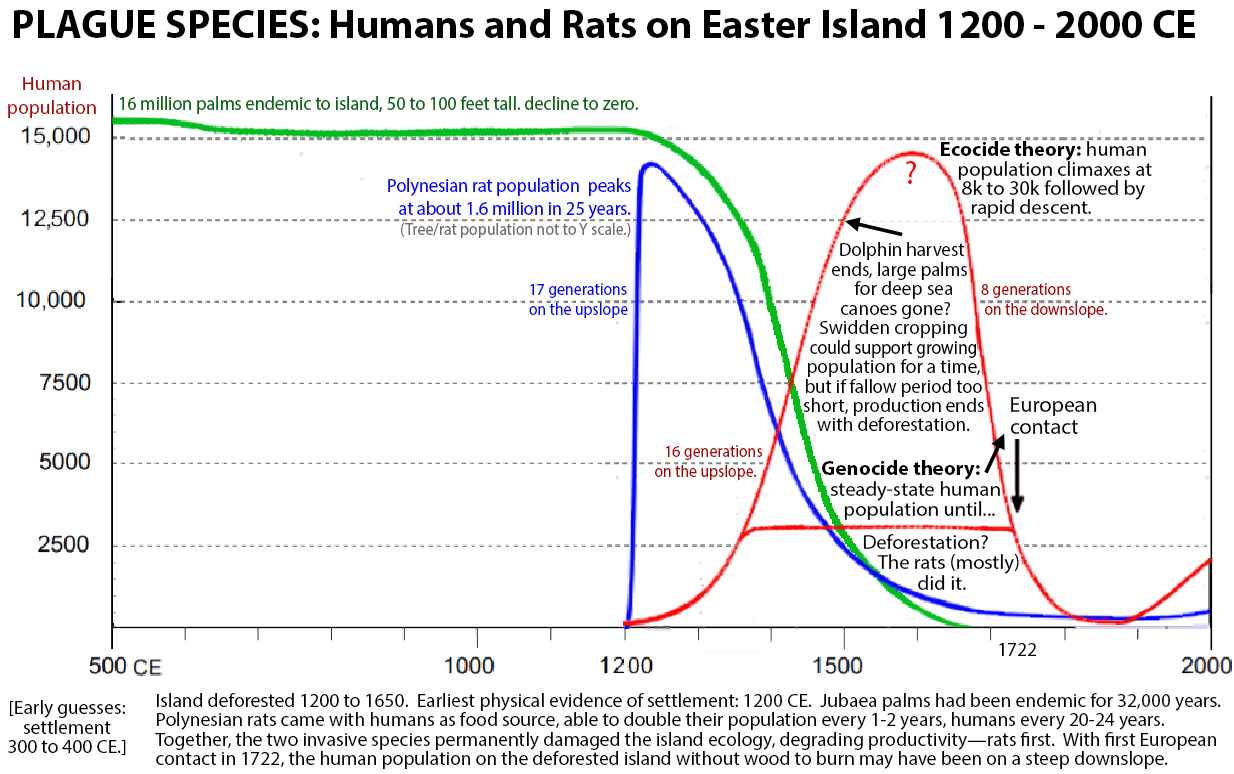
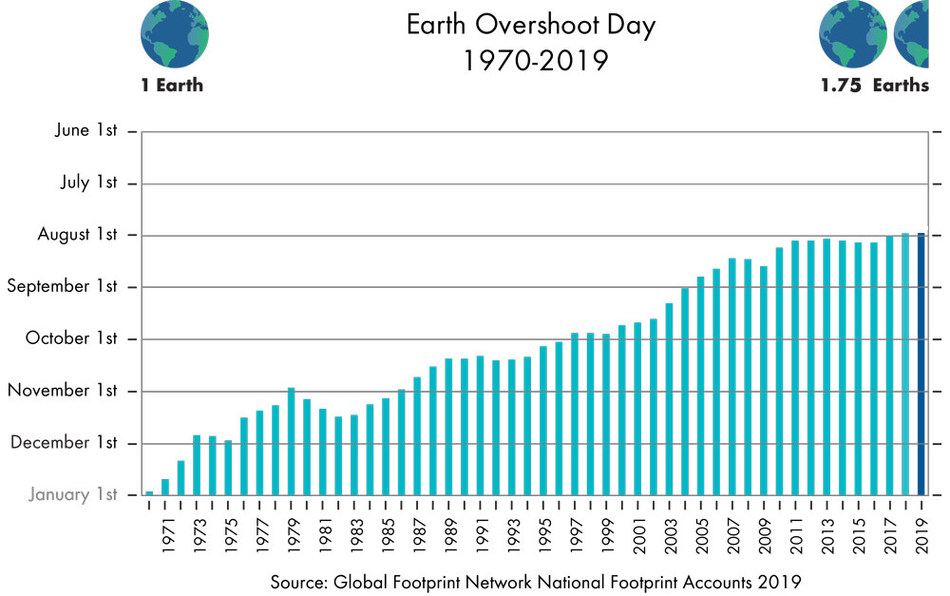
 “
“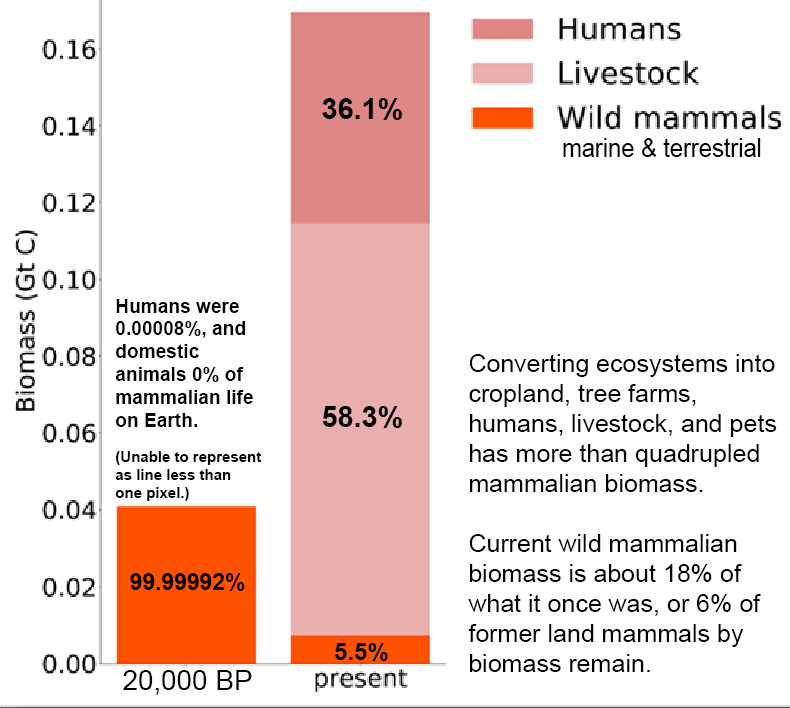
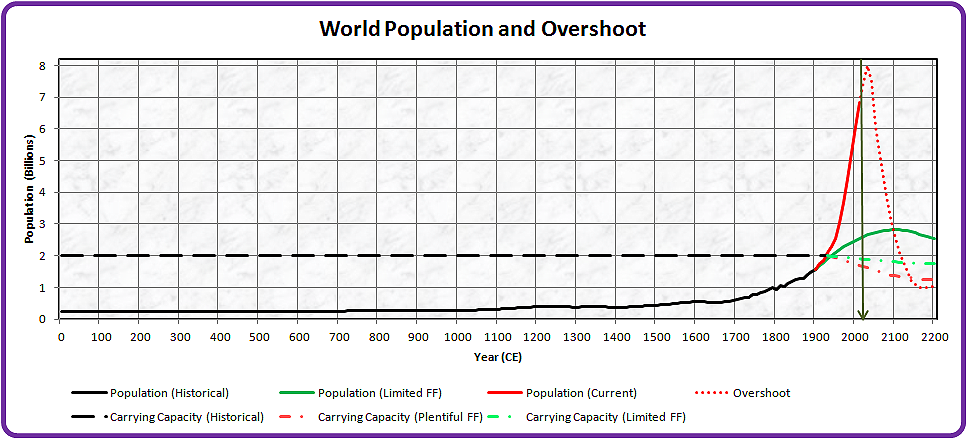
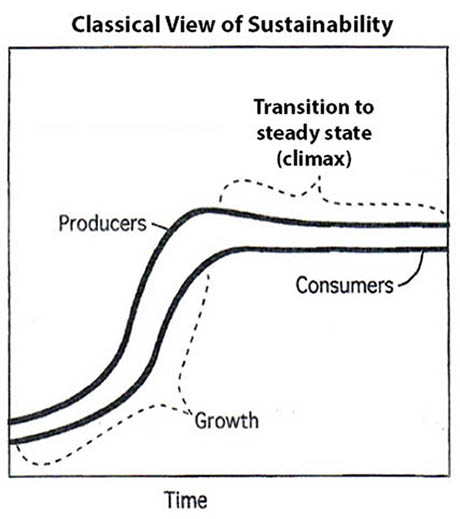
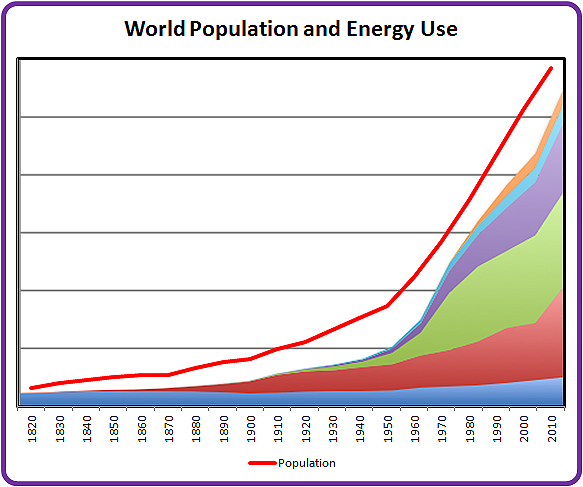

 It’s tempting (largely because it seems vaguely achievable), but unfortunately that number may still be too high. Even in 1800 the signs of human overshoot were clear, if not well recognized: there was already widespread deforestation through Europe and the Middle East; and desertification had set into the previously lush agricultural zones of North Africa and the Middle East.
It’s tempting (largely because it seems vaguely achievable), but unfortunately that number may still be too high. Even in 1800 the signs of human overshoot were clear, if not well recognized: there was already widespread deforestation through Europe and the Middle East; and desertification had set into the previously lush agricultural zones of North Africa and the Middle East.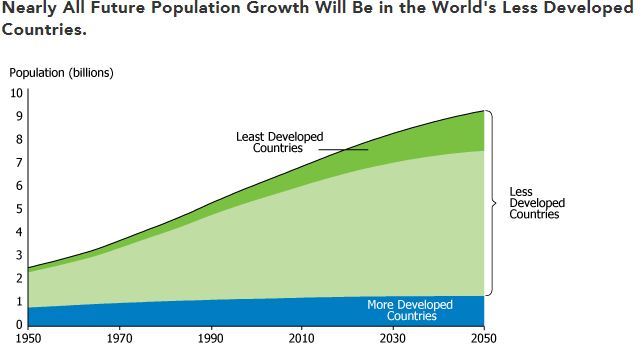 Using the same technique we can calculate that achieving a sustainable population with an American lifestyle (TF = 78) would permit a world population of only 650,000 people – clearly not enough to sustain a modern global civilization.
Using the same technique we can calculate that achieving a sustainable population with an American lifestyle (TF = 78) would permit a world population of only 650,000 people – clearly not enough to sustain a modern global civilization.  The Ecological Footprint doesn't really seem intended as a measure of sustainability. Its main value is to give people with no exposure to ecology some sense that we are indeed over-exploiting our planet. (It also has the psychological advantage of feeling achievable with just a little work.) As a measure of sustainability, it is not helpful.
The Ecological Footprint doesn't really seem intended as a measure of sustainability. Its main value is to give people with no exposure to ecology some sense that we are indeed over-exploiting our planet. (It also has the psychological advantage of feeling achievable with just a little work.) As a measure of sustainability, it is not helpful.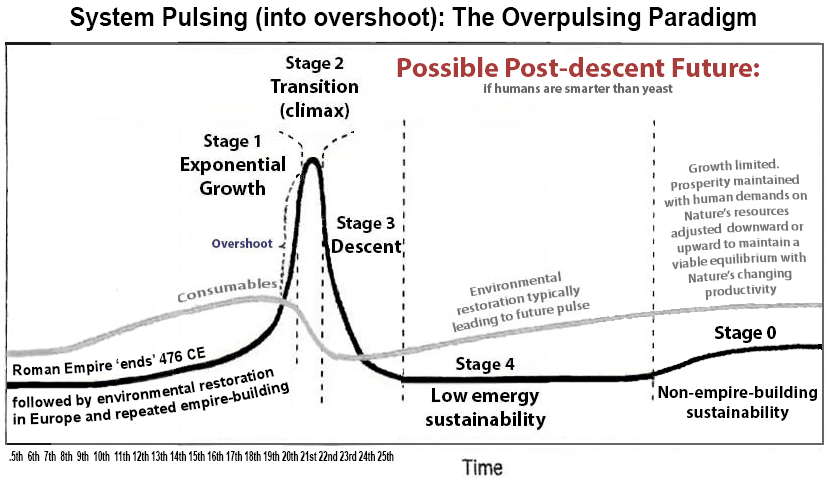
 It's important to remember that this scenario is not a prediction. It's an attempt to portray a potential path down the population hill that seems a bit more probable than a simple, "Crash! Everybody dies."
It's important to remember that this scenario is not a prediction. It's an attempt to portray a potential path down the population hill that seems a bit more probable than a simple, "Crash! Everybody dies."